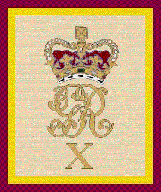H.M . Tenth Regiment of Foot Music Company | home
History of the Tenth Regiment of Foot | Calendar | Band of Music | FAQ's about Fife and Drum | The Role of the Musicians | Overview of this month's events | Photo Index | Related Links | Join His Majesty's Tenth Regiment of Foot | A Day in the Life of a reenactor
A Day in the Life of a reenactor
The Daily Life of a reenactor varies from event to event. I am going to attempt to explain what the daily life of a reenactor is at an average event. Smaller events tend to follow a looser schedule whereas the larger reenactments on the brigade scale tend to be much larger, involving more reenactors and more spectators, so because there are more spectators we must follow a more rigid schedule.
The Morning
8:00 am.
This is the time we generally consume our breakfast. In the Tenth regiment of Foot we do not cook food as individuals. We dine under the communal dinner fly. Officers and Privates eat together. There are a core group of people who prepare the food. This consists of the Camp Quartermaster and a group of distaff, or camp followers, as more commonly known. They are up before the sunrises to bring us a hot meal when we awaken. The Tenth Regiment could not function without these people. Breakfast often consists of Eggs, Breakfast meats, hot cakes, breads such as muffins or scones, and coffee and the like. Those who eat are responsible for cleaning their own utensils such as fork, knife, spoon, bowl or plate, and tin cup. And we are responsible for cleaning the pots, pans, and other regimental utensils used in the preparation of the food. This is not the distaff's job!
9:00 am
This often the time that the Reveille is commenced. Reveille is the duty of the music to awaken the camp by marching, in full finery, up and down the rows of tents to make sure that the men are awake. This, often, is used in camp to signify that you should begin to uniform yourself for the day so that you are, literally not caught with your pants down when you are needed.
10:00am-12:00pm
This is time period often varies from event to event. At one event it may be a time for early morning skirmishes and tacticals. Tacticals are when a regiment shows there might to the opposing force by outmaneuvering and out firing in order to advance and make the opponent retreat. The grenadier company and their commander are wonderful at this. At another event it may consist of drilling the regiment in the manual of arms so that we are spit and polished and professional at Our presentation. At other events it may be down time where the camp duties may occur. Water and wood may be needed so the soldiers are to go and collect it. Yet at other events the music may begin by practicing their marching and perfecting their music for the days marching so as not to mess up the soldiers on the march.
12:00pm
This is the time for the Nooning, or lunch. The lunch fare often consist of sandwiches, leftovers from breakfast, pickled vegetables, and a menagerie of other foods. This yet again is served by the distaff and the camp quartermaster. If there was a morning battle people will often clean there muskets after they have finished eating. Or others may take a shopping trip to the sutlers to buy eighteenth century wares from clothes to equipment to food to muskets. Anything related to the Revolutionary War can be found hear.
1:00pm
Colour ceremony. This is when the trooping of the colours occur. The trooping of the colours is when the colours(flags) are marched in regimental order (1st Foot Guards first, 2nd Coldstream second, and so on). The flags are accompanied by a Grenadier Guard, two Grenadiers from each regiment which act as a ceremonial guard. Accompanying the colours and the Grenadiers are two fifers and a drummer from each company which play a slow march to honor the colors. The entire army will go to present as the colours pass. This is done primarily at Brigade events, rarely at the smaller events. It is done generally before going into battle.
2:00pm-4:00pm
This is the time, often, when the public get to witness the battle. The battle is fought between the British, Loyalists, Germans, and Indians. And the Colonists and sometimes the French. It generally last upwards of to hours. You are expected to look good and perform well. The battle is sort of self explanatory, it is generally the most anticipated part of a reenactment. Enough said.
5:00pm
This is the part the public doesn't see. It is when a reenactor can kick off his shoes, partake in camp games, listen to the music perform, and make Merry with fellow reenactors. You are advised to go to bed at a reasonable hours. 12:00am onward is usually considered the time they feel to hit the hay. Others choose to stay up until 3:00am and be nearly unconscious the next day. Also if you get heavily inebriated do not expect to fight the next day until you are no longer sick.
This completes a day in camp. The Archetype circle continues the next day.
